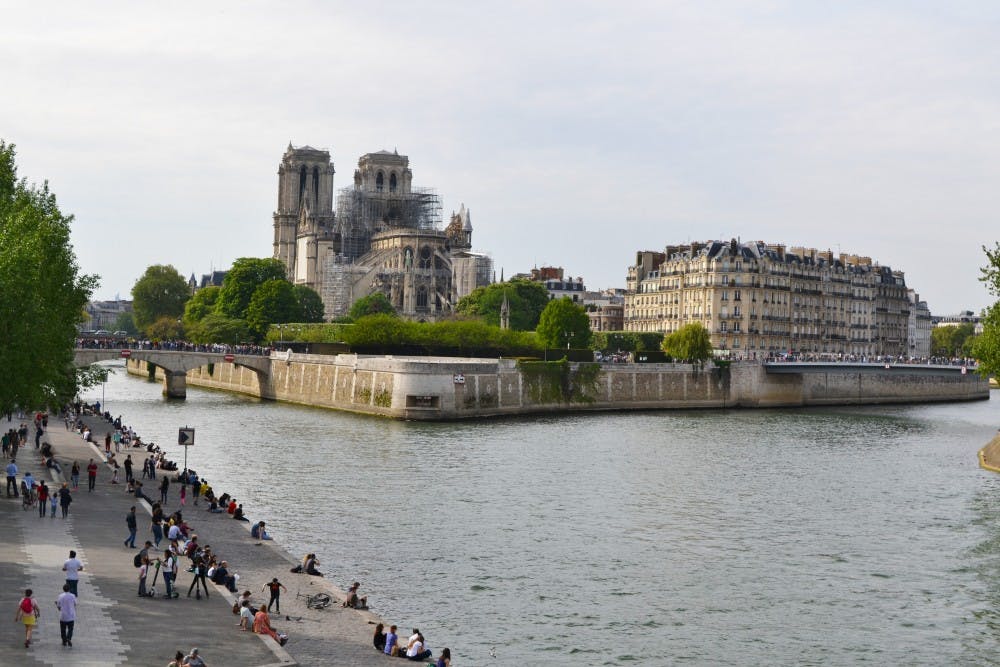One week after Notre Dame caught fire, the crowd massed at the cathedral in Paris was a sight to behold.
We couldn’t inspect it up close. Notre Dame sits on an island in the middle of the Seine river, the Île de la Cité, and police had blocked off access to the island around the cathedral. As a result, tourists swarmed the sidewalks on the other side of the river.
A man lounged against a wall near the crowd’s center. Before him sat an orange sand pail filled with ice and water bottles, a chunk of cardboard taped to it advertising one euro as the price of a bottle. Street vendors are not an unusual sight in Paris. But I wondered whether this was his typical hangout spot or a business-savvy decision made in anticipation of a swell of people.
I hung back, observing the onlookers. Everyone was eager to snap a picture of the cathedral in its crippled state, to cut a slice of the shared memory of its burning for themselves. In the fire, which happened the evening of April 15, the wooden roof and spire were lost, but the structure, towers and facade were saved. Many posed for a photo in front of it—some sober-faced, but most smiling.
I can’t say what motivation compelled me to stop by the church. I’m studying abroad this semester in a city in southern France, Aix-en-Provence, so I can hardly say Notre Dame feels like a part of my France.
I cannot confess a deep connection to the church other than a sorrow for the near-destruction of something old, important and storied, either. My personal tastes made the churches of Saint-Chapelle and Sacré-Cœur dearer to me when I first visited Paris in January. More than anything, I think my visit was prompted by a fascination with public reactions after the fire.
Last semester, I took a class about disaster in American religion and culture, taught by assistant professor Cooper Harriss of the religious studies department. We analyzed several disasters, such as the sinking of the Titanic and 9/11, and considered their cultural contexts and after effects. One of the biggest lessons I took away from the class is how disasters generally follow the same narrative: We react, we grieve and, most importantly, we compete to decide what meaning the tragedy holds.
The Notre Dame fire is no exception. It seemed to strike a huge nerve with people. My social media feeds on April 15 were filled with memories of Notre Dame as it burned. I suspect the outpouring had to do with the searing image of the church in flames, smoke billowing out from it in thick clouds. Fire, after all, is a primal element, one that perhaps resonates deeper with us than a collapse of part of the cathedral’s structure might have.
Here in France, the reaction was similar. The first two days after the fire were consumed by news media seeking to understand what happened and the material implications for the cathedral. As of right now, authorities think the fire was caused by ongoing renovation work.
Then the conversation turned to how the cathedral’s fate is situated within social and economic tensions simmering in France. Donations for restoring Notre Dame have surpassed 900 billion euros, with 100 and 200 million alone coming from billionaires François-Henri Pinault and Bernard Arnault respectively.
This prompted an outcry from activists concerned with economic equality in France. Could the money donated to Notre-Dame’s reconstruction be better used helping the urban poor of Paris? Does the ease with which the wealthy opened their pocketbooks signal a need to increase taxes for the rich?
A younger me might have immediately joined the chorus of people condemning the deluge of grief and money for the cathedral. After all, as my host mom commented, lives are more important than stone monuments.
Whether we like it or not, though, places hold a great deal of power. Notre Dame in particular encompasses this: It’s one of the most visited landmarks in France and for many the symbol of the country itself. What are monuments for if not to remind ourselves we were once there, if not to keep them alive in our memories?
I’m suspicious of any narrative telling us we are not allowed to mourn a loss at the same time we grapple with societal problems rendered more visible by that loss. We are, I believe, capable of juggling both in our consciences.
My last glimpse of Notre Dame in its entirety came on January 28. I was standing in a small park with a lovely view of the cathedral, framing its sharp gothic angles with greenery. Two women approached me and asked if I’d take their photo in front of it. I obliged. After they left, I contemplated the structure I’d dismissed in favor of others, its white stone bright in the rare Parisian sunlight, and snapped my own photo. I’m glad I did.






